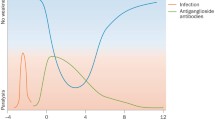Abstract
Guillain-Barré syndrome (GBS) is an autoimmune acute peripheral neuropathy. Frequently a flu-like episode or a gastroenteritis precede GBS, and the cross-reactivity between microbial and neural antigens partly explains the pathophysiology of the disease and the possible detection of antiganglioside antibodies. The weakness reaches its nadir in 2–4 weeks: the patients may be chair- or bed-bound, may need artificial ventilation and frequently experience dysautonomic dysfunction; 5–15% of the patients die and more patients are left with a disabling motor deficit and/or fatigue. Electrophysiology and cerebrospinal fluid evaluation support the diagnosis. The treatment of GBS is multidisciplinary, and both plasma exchange and high dose immunoglobulin (IVIg) are effective in reducing both the severity of the disease and the residual deficits. Finally, steroids are not effective in GBS.
Similar content being viewed by others
Author information
Authors and Affiliations
Corresponding author
Rights and permissions
About this article
Cite this article
Cosi, V., Versino, M. Guillain-Barré syndrome. Neurol Sci 27 (Suppl 1), s47–s51 (2006). https://doi.org/10.1007/s10072-006-0548-4
Issue Date:
DOI: https://doi.org/10.1007/s10072-006-0548-4




